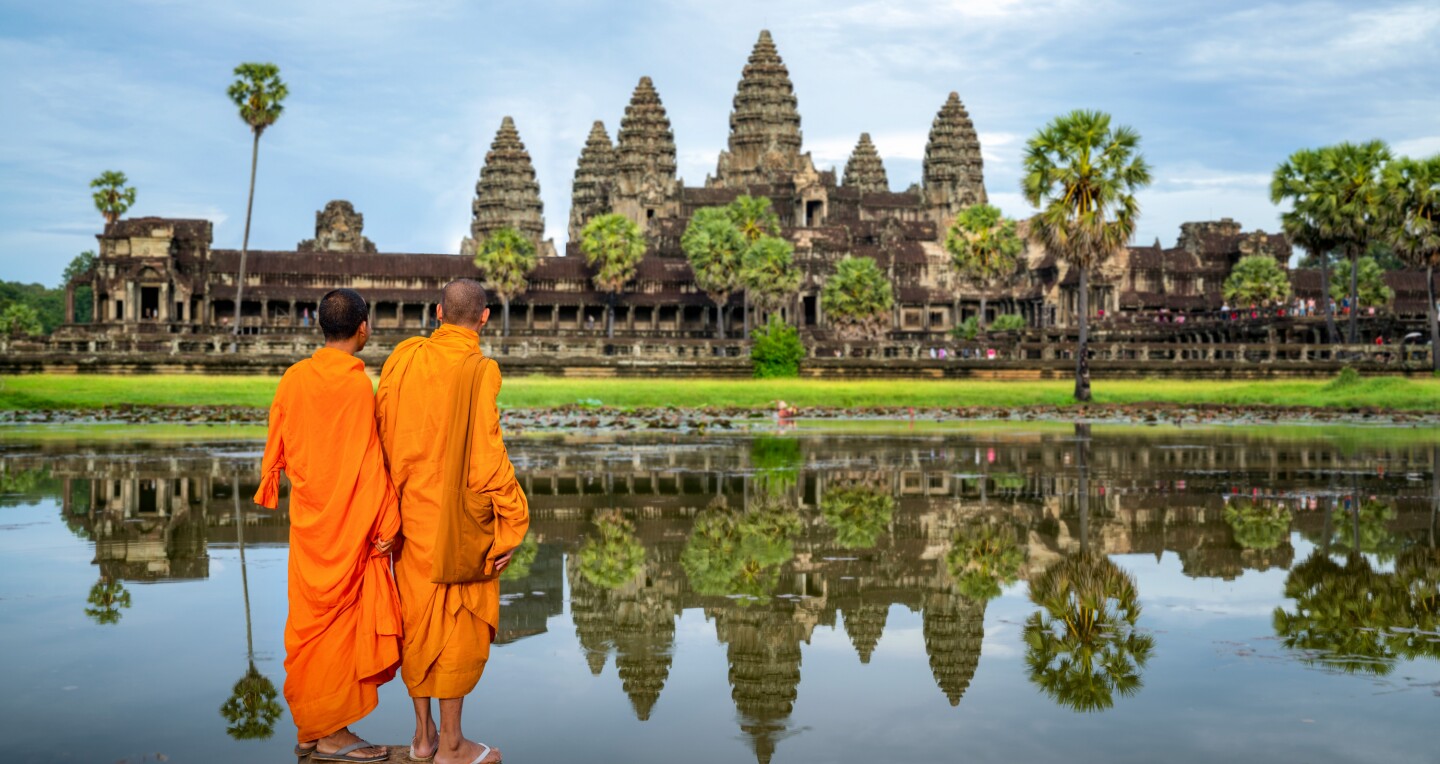Overview
When’s the best time to go to Cambodia?
Cambodia has two seasons—wet (May to October) and dry (November to April)—and both hold charms abundant.
In November, temperatures at night dip to the low 70s, and while you won’t need a raincoat, you may want an umbrella to shield you from the sun and to put some distance between you and the seasonal crowds at Angkor Wat.
April usually means 100 degrees during the day, but that month’s New Year’s festivities are beautiful, with games and dancing and celebratory dishes like the kralan, a delicious roasted coconut rice cake. It’s easy to fall in love with the romance of the monsoon months, when jungles are at their most vibrant, wildlife is abundant, and crowds are blissfully absent.
How to get around Cambodia
A flexible itinerary and easy-going attitude are optimal, as the few existing highways only began seeing extensive asphalt in 2008.
Flights land daily at Phnom Penh International Airport from major Asian cities, via several carriers. Cambodia Angkor Air flies Phnom Penh to Siem Reap and down to the beaches of Sihanoukville for a few hundred dollars, but charter buses are the cheapest and most common option. Private car with drivers are also popular and can shave an hour off of bus time. A private car from the capital to the coast costs around $60 each way.
Cambodia’s Royal Railway––defunct for decades––is running again, and is a romantic-yet-thrifty option ($7+) for travel to Phnom Penh, Sihanoukville, Takeo, and Kampot. The restored cars offer air-conditioning and bathrooms.
In cities or villages or beach towns, tuk tuks can take you where you want to go. And in Battambang, ride the famous Norry trains, bamboo platforms that ramble along tracks to nowhere and back again, reaffirming that “it’s about the journey, not the destination.”
Can’t miss things to do in Cambodia
Millions of people tour Cambodia’s UNESCO-recognized temples, spending the night in lovely boutique hotels in neighboring Siem Reap. Battambang’s mesmerizing local circus gets press for good reason, and a plate of pepper crab in Kampot is an unforgettable indulgence. The sunsets over the emerald waters and white sand of Koh Rong Islands are Instagram gold, and Phnom Penh’s culinary scene is the latest talk of Southeast Asia.
Food and drink to try in Cambodia
Expect ingredients familiar from Thai food, like lemongrass, lime, coconut, soy, sugar, ginger, and vinegar, but without the intense spice. The most common pepper you’ll find is a peppercorn variety native to Kampot. Amok is the national dish: a slightly sweet coconut fish curry, with turmeric, lime, palm sugar, and fish sauce. Bai Sach Chrouk is breakfast—sliced pork over rice with pickled cucumbers—and never skip dessert. In this former French colony, skilled bakers are plentiful.
Culture in Cambodia
This was a powerful kingdom from the 4th to the 14th century, comprising vast sections of Thailand, Laos, and Vietnam. Cambodia has worked its influence on many Asian arts, from carving to dance, ceremonies to architecture. Family is extremely important to the fabric of life, and traditional marriage remains sacred. In rural areas, unmarried women and men avoid physical contact, as sex before marriage is strongly held social taboo. Children begin school around the age of seven and while the father figure in the family usually holds the authority, Cambodians show great respect to the matriarch as well. In the late 1970s and early ‘80s, the Khmer Rouge regime enslaved and murdered millions. A visit to the Killing Fields of Choeung Ek and the Tuol Sleng Genocide Museum in the capital is an important step to understanding the culture’s troubled past and fervent desire for a bright future. The Phnom Penh City Center project––a real estate venture bringing new housing, entertainment, retail, and restaurants––can provide a happy counterpoint in focus. The project is predicted to draw 200,000 people per day by 2025.
Events
One of the most popular annual events is November’s Water Festival, with colorful boat races and fireworks stretching over three days.
In summer, monsoons flood the Mekong River, temporarily forcing its waters back upstream into the lake of Tonlé Sap and bringing rich nutrients to the lake as well as thousands of fish. This is a bountiful time for eating, drinking, and celebrating.
Most events follow the Cambodian Lunar Calendar—the Chhankitek—but that’s not to say all are religious or agricultural. The Johnnie Walker Golf Tournament at the Phokeethra Country Club in Siem Reap is held in autumn. Marathons are popular, too, including the International Half Marathon in December and the Ultra Trail d’Angkor in January.
For Families
At the Battambang Phare Ponleu Selpak Circus, performers of all ages mix comedy and satire with breathtaking acts under a ‘big top’ tent. This city’s Norry trains are also popular families. Passengers whizz through the jungle on bamboo platforms propelled by small motors. (The rigs were originally used to transport agriculture between villages.) The Russian Market and weekend night market in Phnom Penh offer a million entertaining sights, sounds, and toys for sale, and the koi fish pond at the National Museum is a kid favorite.
Local travel tips for Cambodia
Theft is common in the capital. Avoid wearing jewelry or using your cell phone on the street. Cambodians traditionally cover their knees and shoulders, and this practice is enforced at holy sites and temples. Unmarried women and men avoid touching. Putting your arm around a stranger for a photo or touching a child may be misunderstood.
Local Resources
Guide Editor
Jenny Adams is a full-time freelance writer and photographer, who over the last decade has spent six months a year living in Southeast Asia. She formerly worked for an NGO in Sihanoukville, Cambodia. Jenny catalogs her triumphs and mishaps on her blog, www.BuddhaDrinksFanta.com. She covers food, cocktails, and off-the-beaten-track travel stories for a number of publications.






